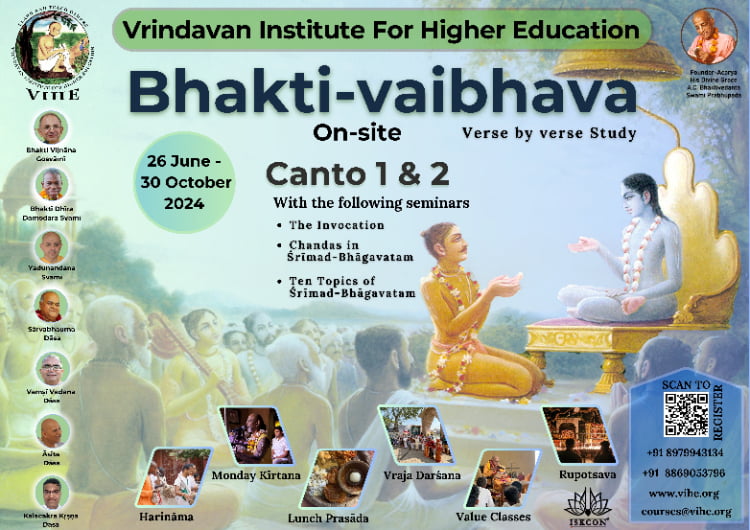Encylopedia of Global Religion Includes Authoritative Entries on ISKCON
By Madhava Smullen | Dec 10, 2011

The new two-volume “Encyclopedia of Global Religion,” released this October by the academic publisher SAGE, features substantial and authoritative entries on ISKCON, Srila Prabhupada, and Vaishnavism.
The coffee-table sized volumes, which run to 1,528 pages, provide a comprehensive overview of religious culture and society around the world, in both its historical and contemporary aspects.
Its editors, Mark Juergensmeyer and Wade Clark Roof, are sociologists of religion at the University of California, Santa Barbara, and are respected authors and religious scholars, while Juergensmeyer has specialized in South Asian and Hindu studies. Together, they contacted leading authorities on various religions from around the world to contribute to the encyclopedia.
One of these was Steven J. Rosen, or Satyaraja Dasa, a disciple of ISKCON founder Srila Prabhupada, and author of twenty-nine books in numerous languages, including The Hidden Glory of India and Krishna’s Song: A New Look at the Bhagavad-gita.
Satyaraja was deemed especially eligible for the job of writing entries on ISKCON, Prabhupada, and Vaishnavism for two reasons. Firstly, he had a reputation as a scholar of Vaishnavism. This he developed over twenty years as founding editor of the highly respected Journal of Vaishnava Studies.
He was also recommended by Harvard Professor Francis X. Clooney to write a high-school text book on Hinduism, which came out as part of a six-volume series on the world’s religions for the major academic press Praeger-Greenwood. This project was parlayed into an additional volume called Essential Hinduism, which Praeger asked Satyaraja to write as an advanced treatise on the subtleties of how to teach Hinduism.
Secondly, as not only a scholar of the tradition, but a practioner too, he had the kind of practical insights, in-depth understanding, and sensitivity to the subject matter that non-practioner scholars may not.
“One of the reasons I got into scholarship, and started the Journal of Vaishnava Studies was because I saw so much misinformation getting out there about ISKCON and the Vaishnava tradition,” Satyaraja says. “For instance, I’ve seen ISKCON described as ‘a new religious movement,’ without any acknowledgement of its roots in India.”
In contrast, the Encyclopedia of Global Religion’s entry on ISKCON does carefully explain its roots: “Now a worldwide confederation of Krishna devotees, ISKCON is essentially a monotheistic Hindu tradition in the Gaudiya Vaishnava tradition. Its connection to Gaudiya Vaishnavism comes through Prabhupada himself, who, as a primary disciple of Srila Bhaktisiddhanta Sarasvati Thakur, a renowned scholar and saint who founded an earlier ISKCON-like institution known as the Gaudiya Math, inherited the lineage mantle from his teacher.”

The Encyclopedia of Global Religion with editors Mark Juergensmeyer and Wade Clark Roof
The entry also addresses another misconception about ISKCON—that it is a ‘Hindu’ movement:
“Prabhupada founded ISKCON as a universalist institution, advocating sanatana dharma (‘traditional religion,’ a term that the movement translates as ‘the eternal function of the soul’) as opposed to sectarian concerns. Accordingly, he never identified his institution as a form of Hinduism. Instead, ISKCON teaches what Prabhupada called ‘the science of God consciousness.’ In other words, the institution eschews normal religious identification, such as Hindu, Jew, Christian, Buddhist, or Muslim, and, instead, focuses on the abiding truths and underlying threads that tie all religions together.”
Meanwhile, the entry on Srila Prabhupada does away with misrepresented information on ISKCON’s founder—one other textbook described him as a “pharmaceutical entrepreneur”—while considering the encyclopedia’s broad audience.
“When writing for ISKCON devotees, you can simply describe Srila Prabhupada as ‘a pure devotee,’ and that kind of says it all,” Satyaraja says. “But that doesn’t mean anything to the general public, so instead I tried to show objectively why he was a significant personality, by listing his contributions and virtues that are unassailable and could be appreciated by anyone.”
So, instead of using the phrase ‘pure devotee,’ Satyaraja writes, “Born Abhay Charan De, in Calcutta (now Kolkata), West Bengal, Prabhupada studied at the Scottish Churches College, which was administered by the British and functioned under the auspices of Christian missionaries. Still, his parents raised him as an orthodox Vaishnava—a devotee of ‘the Supreme Personality of Godhead’—and he claimed that there was never a time in his life when he forgot Krishna.”
Meanwhile Prabhupada’s achievements are described in detail, in a way that an outside audience could appreciate: “In the 12 years from his arrival in New York until his final days, he circled the globe 14 times on lecture tours that took him to six continents; introduced Vedic gurukul (children’s education) to a Western audience; directed the founding of the Bhaktivedanta Book Trust, which claims to be the world’s largest publisher of ancient and classical Vaishnava religious texts; founded the religious farm community New Vrindavan in West Virginia; authored 60 books on Vedantic philosophy, religion, literature, and culture, which are now available in numerous languages; and watched ISKCON grow into a confederation of more than 100 schools, temples, institutes, farm communities, and ashrams.”
Finally, on the very first page of the Encyclopedia of Global Religion’s “V” section is Satyaraja’s entry on Vaishnavism.
Pointing out just how many followers Vaishnavism has, it clarifies common misconceptions about “worshiping many gods” or impersonalism along the way:
“As commonly understood, Vaishnavism is a prototypical form of Hinduism focusing on Vishnu(or His many manifestations and incarnations) as the Supreme Being. It is a form of monotheism that perceives other deities as subordinate, viewing them as demigods, angels, or empowered beings. Vaishnavism claims many millions of adherents, for it is the most widely practiced form of Hinduism in the Indian subcontinent.”
And again, the entry gets to the heart of the spiritual path as understood by Vaishnava practioners:
“Devotional service” (Bhakti yoga) is the mystical path by which one can enter into a relationship with God—it supersedes all pious action, the cultivation of knowledge, and various mystical endeavors, such as yoga and meditation (though in its practice it subsumes various forms of yogic mysticism),” Satyaraja writes. “The science of this holy devotion is detailed in scriptures such as the Bhagavad Gita and the Bhagavata Purana, but it is chiefly understood by associating with devotees who carry it in their hearts. The central practices of this path include singing the praises of God, chanting His names in a regulated fashion, offering food to Him as a sacrament of devotion, and worshipping His image in the temple or in one’s home.”
The entry concludes with the powerful statement: “Pure love of God alone is the ultimate fruit of the spiritual journey, and it is the essence of Vaishnava thought.”
Satyaraja is happy to have been able to contribute to a major reference book that will be used in comparative religion courses around the United States and the world.
“I feel honored to have been asked to write about subjects so close to my heart,” he says.
Purchase The Encyclopedia of Global Religion here: http://www.sagepub.com/books/Book225428












